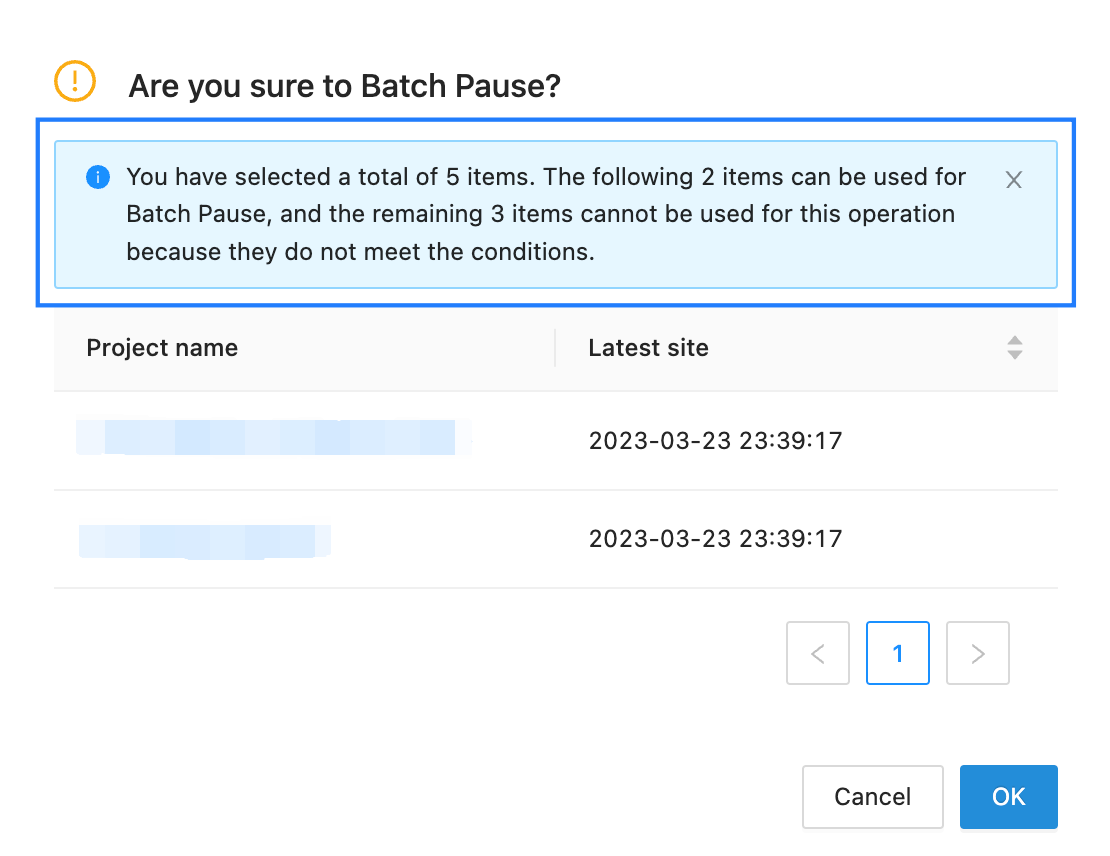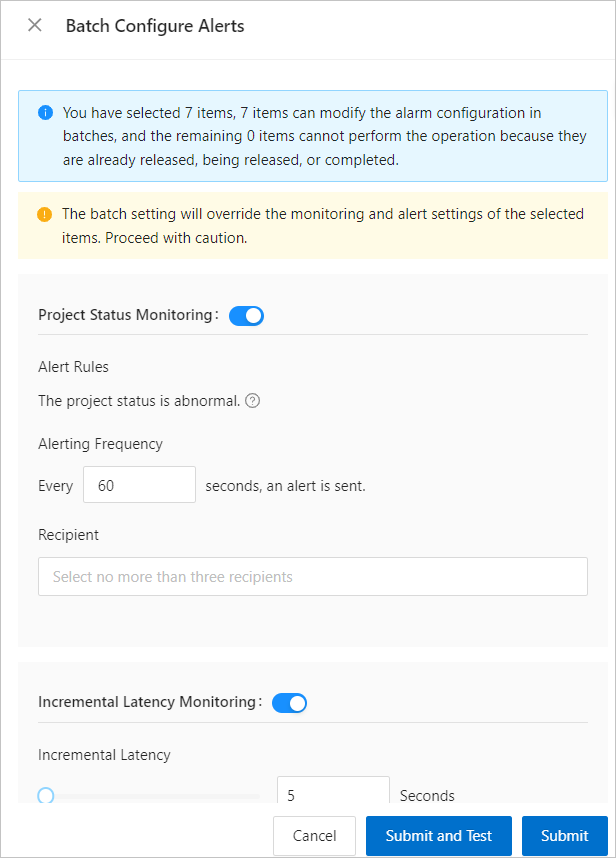This topic describes how to use the data transmission service to perform batch operations on data synchronization projects.
Background information
The data transmission service allows you to perform batch operations on data synchronization projects on the Synchronization Projects page. Supported batch operations on data synchronization projects vary based on the project status.
Project status | Supported batch operation |
Not Configured | N/A |
Not Started | Batch start projects and batch modify alert configuration. |
Running | Batch pause projects and batch modify alert configuration. |
Modifying | Batch modify alert configuration. |
Integrating | Batch modify alert configuration. |
Paused | Batch resume projects, batch stop projects, and batch modify alert configuration. |
Failed | Batch resume projects, batch stop projects, and batch modify alert configuration. |
Completed | Batch stop projects. |
Stopping | N/A |
Stopped | N/A |
If you select multiple projects for a batch operation while not all projects support this batch operation, a dialog box appears and displays the projects that support this batch operation.

Go to the Synchronization Projects page
Log on to the ApsaraDB for OceanBase console.
In the left-side navigation pane, choose Data Transmission > Data Synchronization. The Synchronization Projects page automatically appears.
You can select data synchronization projects for a batch operation.

Batch pause projects
The data transmission service allows you to batch pause data synchronization projects in the Running state.
On the Synchronization Projects page, select the data synchronization projects to be paused.
Click Batch Pause in the lower part of the page.

In the dialog box that appears, click OK.
This dialog box displays the number of projects that support batch pausing, the project names, and the latest timestamps.

After the operation succeeds, the number of projects that are successfully paused is displayed.
For any project that failed the batch operation, troubleshoot the issue as prompted.
Batch resume projects
The data transmission service allows you to batch resume data synchronization projects in the Paused or Failed state.
On the Synchronization Projects page, select the data synchronization projects to be resumed.
Click Batch Restore in the lower part of the page.

In the dialog box that appears, click OK.
This dialog box displays the number of projects that support batch restoration, the project names, and the latest timestamps.
After the operation succeeds, the number of projects that are successfully resumed is displayed.
For any project that failed the batch operation, troubleshoot the issue as prompted.
Batch stop projects
The data transmission service allows you to batch stop data synchronization projects in the Paused, Failed, or Completed state.
On the Synchronization Projects page, select the data synchronization projects to stop.
Click Batch Stop in the lower part of the page.

In the dialog box that appears, click OK.
This dialog box displays the number of projects that support batch stop, the project names, and the latest timestamps.
After the operation succeeds, the number of projects that are successfully stopped is displayed.
For any project that failed the batch operation, troubleshoot the issue as prompted.
Batch start projects
The data transmission service allows you to batch start data synchronization projects in the Not Started state.
On the Synchronization Projects page, select the data synchronization projects to start.
Click Batch Start in the lower part of the page.

In the dialog box that appears, click OK.
This dialog box displays the number of projects that support batch start, the project names, and the latest timestamps.
After the operation succeeds, the number of projects that are successfully started is displayed.
For any project that failed the batch operation, troubleshoot the issue as prompted.
Batch modify alert configuration
The data transmission service allows you to batch modify alert configuration for data synchronization projects in the Not Started, Running, Modifying, Integrating, Paused, or Failed state.
On the Synchronization Projects page, select the data synchronization projects for which you want to modify alert configuration.
Choose More Batch Operations > Batch Modify Alert Configuration in the lower part of the page.

In the Batch Configure Alerts dialog box, set the related parameters based on your business needs.
On the Synchronization Projects page, you can check whether alert configuration has been completed for a specific project. If alert configuration is not completed for a project, you can choose whether to enable Project Status Monitoring or Incremental Latency Monitoring based on your business needs. You can also modify the alert configuration of a project.
ImportantThe new configuration overwrites the existing configuration of the selected projects. Proceed with caution.

Category
Parameter
Description
Enable Project Status Monitoring
Alert Rules
An alert is triggered if an exception is detected in the project.
All exceptions that occur during the execution of schema synchronization, incremental synchronization log pull, full synchronization, and incremental synchronization tasks can be detected.
Alerting Frequency
The interval for sending alerts. Value range: 60 to 604800 (in seconds). That is, the interval must not be shorter than 60s or exceed 7 days.
Recipient
The recipient of alerts. You can select a maximum of three recipients.
If the recipient that you want to select is not in the drop-down list, click Add Alert Contact to go to the CloudMonitor console and add the recipient.
Enable Incremental Latency Monitoring
Incremental Latency
The alerting threshold of the incremental synchronization latency.
For a data synchronization project, if the incremental synchronization latency exceeds the specified threshold, an alert is triggered.
Alerting Frequency
The interval for sending alerts. Value range: 60 to 604800 (in seconds). That is, the interval must not be shorter than 60s or exceed 7 days.
Recipient
The recipient of alerts. You can select a maximum of three recipients.
If the recipient that you want to select is not in the drop-down list, click Add Alert Contact to go to the CloudMonitor console and add the recipient.